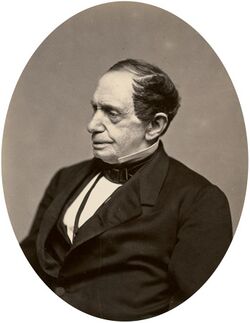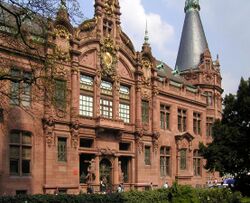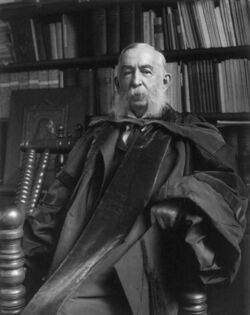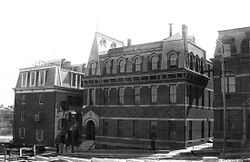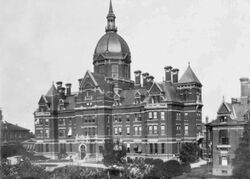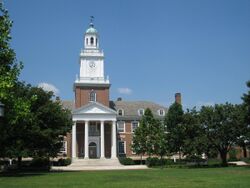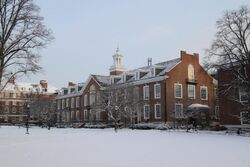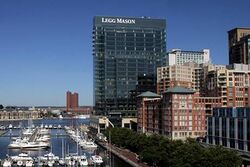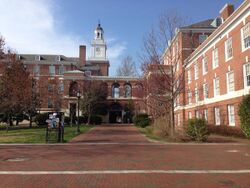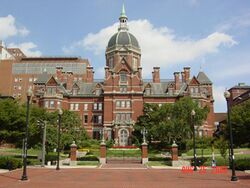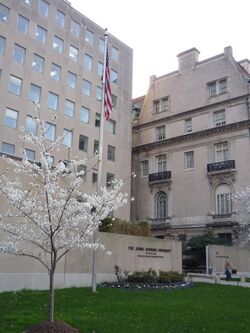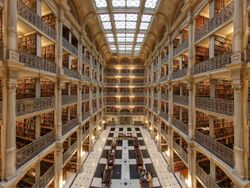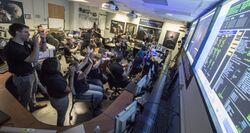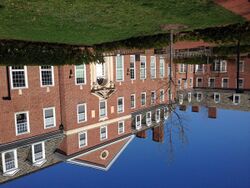Johns Hopkins University
Topic: Organization
 From HandWiki - Reading time: 35 min
From HandWiki - Reading time: 35 min
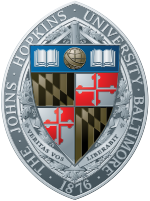 | |
| Motto | Veritas vos liberabit (Latin) |
|---|---|
Motto in English | "The truth will set you free" |
| Type | Private research university |
| Established | February 22, 1876 |
Academic affiliations |
|
| Endowment | $9.32 billion (2021)[1] |
| President | Ronald J. Daniels |
| Provost | Ray Jayawardhana |
| Students | 30,549 (2022) |
| Undergraduates | 5,318 (2022)[2]:19 |
| Postgraduates | 25,231 (2022)[2]:19 |
| Location | Baltimore , Maryland , United States [ ⚑ ] : 39°19′44″N 76°37′13″W / 39.32889°N 76.62028°W |
| Campus | Large city[3] |
| Other campuses |
|
| Newspaper | The Johns Hopkins News-Letter |
| |u}}rs | Heritage blue and spirit blue[4] |
| Nickname | Blue Jays |
Sporting affiliations |
|
| Mascot | Blue Jay |
| Website | jhu.edu |
Johns Hopkins University[lower-alpha 1] (often abbreviated as Johns Hopkins, Hopkins, or JHU) is a private research university in Baltimore, Maryland. Founded in 1876, Johns Hopkins was the first U.S. university based on the European research institution model.[6]
While its primary campus is in Baltimore, Johns Hopkins also maintains ten divisions on campuses in other Maryland locations, including Laurel, Rockville, Columbia, Aberdeen, California, Elkridge, and Owings Mills.[7] The two undergraduate divisions, the Zanvyl Krieger School of Arts and Sciences and the Whiting School of Engineering are located on the Homewood campus in Baltimore's Charles Village neighborhood.[8] The medical school, nursing school, Bloomberg School of Public Health, and Johns Hopkins Children's Center are located on the Medical Institutions campus in East Baltimore.[9] The university also consists of the Peabody Institute, Applied Physics Laboratory, Paul H. Nitze School of Advanced International Studies, School of Education, Carey Business School, and various other facilities.[10] The university also has graduate campuses in Italy, China, and Washington, D.C.[11]
As of October 2019, 39 Nobel laureates and one Fields Medalist have been affiliated with Johns Hopkins's faculty and alumni.[12] Founded in 1883, the Blue Jays men's lacrosse team has captured 44 national titles[13] and plays in the Big Ten Conference as an affiliate member.[14] The university's other sports teams compete in Division III of the NCAA as members of the Centennial Conference.
History
Philanthropic beginnings and foundation
On his death in 1873, Johns Hopkins, a Quaker entrepreneur and childless bachelor, bequeathed $7 million (approximately $147.5 million today adjusted for consumer price inflation) to fund a hospital and university in Baltimore.[15]
At the time, this donation, generated primarily from the Baltimore and Ohio Railroad,[16] was the largest philanthropic gift in the history of the United States,[17] and endowment was then the largest in America.[18] Until 2020, Hopkins was assumed to be a fervent abolitionist, until research done by the school into his United States Census records revealed he claimed to own at least five household slaves in the 1840 and 1850 decennial censuses.[19][20]
The first name of philanthropist Johns Hopkins comes from the surname of his great-grandmother, Margaret Johns, who married Gerard Hopkins.[16] They named their son Johns Hopkins, who named his own son Samuel Hopkins. Samuel named one of his sons for his father, and that son became the university's benefactor. Milton Eisenhower, a former university president, once spoke at a convention in Pittsburgh where the master of ceremonies introduced him as "President of John Hopkins." Eisenhower retorted that he was "glad to be here in Pittburgh."[21]
The original board opted for an entirely novel university model dedicated to the discovery of knowledge at an advanced level, extending that of contemporary Germany.[22] Building on the Humboldtian model of higher education, the Germany education model of Wilhelm von Humboldt, it became dedicated to research. It was especially Heidelberg University and its long academic research history on which the new institution tried to model itself.[22][failed verification] Johns Hopkins thereby became the model of the modern research university in the United States. Its success eventually shifted higher education in the United States from a focus on teaching revealed and/or applied knowledge to the scientific discovery of new knowledge.[23]
| Wikisource has the text of a 1911 Encyclopædia Britannica article about the Early History. |
19th century
The trustees worked alongside four notable university presidents, Charles W. Eliot of Harvard University, Andrew D. White of Cornell University, Noah Porter of Yale College, and James B. Angell of University of Michigan. They each supported Daniel Coit Gilman to lead the new university and he became the university's first president.[24] Gilman, a Yale-educated scholar, had been serving as president of the University of California, Berkeley prior to this appointment.[24] In preparation for the university's founding, Gilman visited University of Freiburg and other German universities.
Gilman launched what many at the time considered an audacious and unprecedented academic experiment to merge teaching and research. He dismissed the idea that the two were mutually exclusive: "The best teachers are usually those who are free, competent and willing to make original researches in the library and the laboratory," he stated.[25] To implement his plan, Gilman recruited internationally known researchers including the mathematician James Joseph Sylvester; the biologist H. Newell Martin; the physicist Henry A. Rowland, the first president of the American Physical Society, the classical scholars Basil Gildersleeve, and Charles D. Morris;[26] the economist Richard T. Ely; and the chemist Ira Remsen, who became the second president of the university in 1901.[27]
Gilman focused on the expansion of graduate education and support of faculty research. The new university fused advanced scholarship with such professional schools as medicine and engineering. Hopkins became the national trendsetter in doctoral programs and the host for numerous scholarly journals and associations.[28] The Johns Hopkins University Press, founded in 1878, is the oldest American university press in continuous operation.[29]
With the completion of Johns Hopkins Hospital in 1889 and the medical school in 1893, the university's research-focused mode of instruction soon began attracting world-renowned faculty members who would become major figures in the emerging field of academic medicine, including William Osler, William Halsted, Howard Kelly, and William Welch.[30] Students came from all over the world to study at Johns Hopkins and returned to their sending country to serve their nation, including Dr Harry Chung (b. 1872) who served as a diplomat in the Manchu Dynasty and First Secretary to the United States. During this period Hopkins made more history by becoming the first medical school to admit women on an equal basis with men and to require a Bachelor's degree, based on the efforts of Mary E. Garrett, who had endowed the school at Gilman's request.[31] The school of medicine was America's first coeducational, graduate-level medical school, and became a prototype for academic medicine that emphasized bedside learning, research projects, and laboratory training.
In his will and in his instructions to the trustees of the university and the hospital, Hopkins requested that both institutions be built upon the vast grounds of his Baltimore estate, Clifton. When Gilman assumed the presidency, he decided that it would be best to use the university's endowment for recruiting faculty and students, deciding to, as it has been paraphrased, "build men, not buildings."[32] In his will Hopkins stipulated that none of his endowment should be used for construction; only interest on the principal could be used for this purpose. Unfortunately, stocks in The Baltimore and Ohio Railroad, which would have generated most of the interest, became virtually worthless soon after Hopkins's death. The university's first home was thus in Downtown Baltimore, delaying plans to site the university in Clifton.[15]
20th century
In the early 20th century, the university outgrew its buildings and the trustees began to search for a new home. Developing Clifton for the university was too costly, and 30 acres (12 ha) of the estate had to be sold to the city as public park. A solution was achieved by a team of prominent locals who acquired the estate in north Baltimore known as the Homewood Campus of Johns Hopkins University. On February 22, 1902, this land was formally transferred to the university. The flagship building, Gilman Hall, was completed in 1915. The School of Engineering relocated in Fall of 1914 and the Zanvyl Krieger School of Arts and Sciences followed in 1916. These decades saw the ceding of lands by the university for the public Wyman Park and Wyman Park Dell and the Baltimore Museum of Art, coalescing in the contemporary area of 140 acres (57 ha).[15]
Prior to becoming the main Johns Hopkins campus, the Homewood estate had initially been the gift of Charles Carroll of Carrollton, Maryland, a planter and signer of the Declaration of Independence, to his son Charles Carroll Jr. The original structure, the 1801 Homewood House, still stands and serves as an on-campus museum.[33] The brick and marble Federal style of Homewood House became the architectural inspiration for much of the university campus versus the Collegiate Gothic style of other historic American universities.[33]
In 1909, the university was among the first to start adult continuing education programs and in 1916 it founded the nation's first school of public health.[34]
Since the 1910s, Johns Hopkins University has famously been a "fertile cradle" to Arthur Lovejoy's history of ideas.[35]
| Name | Term |
|---|---|
| Daniel Coit Gilman | May 1875 – August 1901 |
| Ira Remsen | September 1901 – January 1913 |
| Frank Goodnow | October 1914 – June 1929 |
| Joseph Sweetman Ames | July 1929 – June 1935 |
| Isaiah Bowman | July 1935 – December 1948 |
| Detlev Bronk | January 1949 – August 1953 |
| Lowell Reed | September 1953 – June 1956 |
| Milton S. Eisenhower | July 1956 – June 1967 |
| Lincoln Gordon | July 1967 – March 1971 |
| Milton S. Eisenhower | March 1971 – January 1972 |
| Steven Muller | February 1972 – June 1990 |
| William C. Richardson | July 1990 – July 1995 |
| Daniel Nathans | June 1995 – August 1996 |
| William R. Brody | August 1996 – February 2009 |
| Ronald J. Daniels | March 2009–Present |
Since 1942, the Johns Hopkins Applied Physics Laboratory (APL) has served as a major governmental defense contractor. In tandem with on-campus research, Johns Hopkins has every year since 1979 had the highest federal research funding of any American university.[36]
Professional schools of international affairs and music were established in 1950 and 1977, respectively, when the Paul H. Nitze School of Advanced International Studies[37] in Washington, D.C., and the Peabody Institute[38] in Baltimore were incorporated into the university.
21st century
The early decades of the 21st century saw expansion across the university's institutions in both physical and population sizes. Notably, a planned 88-acre expansion to the medical campus began in 2013.[39] Completed construction on the Homewood campus has included a new biomedical engineering building in the Johns Hopkins University Department of Biomedical Engineering, a new library, a new biology wing, an extensive renovation of the flagship Gilman Hall, and the reconstruction of the main university entrance.[40]
These years also brought about the rapid development of the university's professional schools of education and business. From 1999 until 2007, these disciplines had been joined within the School of Professional Studies in Business and Education (SPSBE), itself a reshuffling of several earlier ventures. The 2007 split, combined with new funding and leadership initiatives, has led to the simultaneous emergence of the Johns Hopkins School of Education and the Carey Business School.[41]
On November 18, 2018, it was announced that Michael Bloomberg would make a donation to his alma mater of $1.8 billion, marking the largest private donation in modern history to an institution of higher education and bringing Bloomberg's total contribution to the school in excess of $3.3 billion.[42][43][44][45][46][47] Bloomberg's $1.8 billion gift allows the school to practice need-blind admission and meet the full financial need of admitted students.[48][49]
In January 2019, the university announced[50] an agreement to purchase the Newseum, located at 555 Pennsylvania Ave. NW, in the heart of Washington, D.C., with plans to locate all of its Washington, D.C.-based graduate programs there. In an interview with The Atlantic, the president of Johns Hopkins stated that, "the purchase is an opportunity to position the university, literally, to better contribute its expertise to national- and international-policy discussions."[51]
In late 2019, the university's Coronavirus Research Center began tracking worldwide cases of the COVID-19 pandemic by compiling data from hundreds of sources around the world.[52] This led to the university becoming one of the most cited sources for data about the pandemic.[52]
Civil rights
African-Americans
Hopkins was a prominent abolitionist who supported Abraham Lincoln during the American Civil War. After his death, reports said his conviction was a decisive factor in enrolling Hopkins's first African-American student, Kelly Miller, a graduate student in physics, astronomy and mathematics.[53] As time passed, the university adopted a "separate but equal" stance more like other Baltimore institutions.[18]
The first black undergraduate entered the school in 1945 and graduate students followed in 1967.[54] James Nabwangu, a British-trained Kenyan, was the first black graduate of the medical school.[55] African-American instructor and laboratory supervisor Vivien Thomas was instrumental in developing and conducting the first successful blue baby operation in 1944.[56] Despite such cases, racial diversity did not become commonplace at Johns Hopkins institutions until the 1960s and 1970s.
Women
Hopkins's most well-known battle for women's rights was the one led by daughters of trustees of the university; Mary E. Garrett, M. Carey Thomas, Mamie Gwinn, Elizabeth King, and Julia Rogers.[57] They donated and raised the funds needed to open the medical school, and required Hopkins's officials to agree to their stipulation that women would be admitted. The nursing school opened in 1889 and accepted women and men as students.[58] Other graduate schools were later opened to women by president Ira Remsen in 1907. Christine Ladd-Franklin was the first woman to earn a PhD at Hopkins, in mathematics in 1882.[59] The trustees denied her the degree for decades and refused to change the policy about admitting women. In 1893, Florence Bascomb became the university's first female PhD.[57] The decision to admit women at undergraduate level was not considered until the late 1960s and was eventually adopted in October 1969. As of 2009–2010, the undergraduate population was 47% female and 53% male.[60] In 2020, the undergraduate population of Hopkins was 53% female.[61][62]
Freedom of speech
On September 5, 2013, cryptographer and Johns Hopkins university professor Matthew Green posted a blog entitled, "On the NSA", in which he contributed to the ongoing debate regarding the role of NIST and NSA in formulating U.S. cryptography standards. On September 9, 2013, Green received a take-down request for the "On the NSA" blog from interim Dean Andrew Douglas from the Johns Hopkins University Whiting School of Engineering.[63] The request cited concerns that the blog had links to sensitive material. The blog linked to already published news articles from The Guardian , The New York Times , and ProPublica.org. Douglas subsequently issued a personal on-line apology to Green.[64] The event raised concern over the future of academic freedom of speech within the cryptologic research community.
Campuses
| Main campuses & divisions | ||||||||||
|---|---|---|---|---|---|---|---|---|---|---|
| Homewood | East Baltimore (Medical Institutions Campus) |
Downtown Baltimore | Washington D.C. | Laurel, Maryland | ||||||
| School of Arts and Sciences 1876 |
School of Education 1909 |
School of Engineering 1913 |
School of Nursing 1889 |
School of Medicine 1893 |
School of Public Health 1916 |
Peabody Institute 1857 |
School of Business 2007 |
School of Advanced International Studies 1943 |
Applied Physics Laboratory 1942 | |
Homewood
- School of Education: Originally established in 1909 as The School of Professional Studies in Business and Education, the divisions of Education and Business became separate schools in 2007.
- Whiting School of Engineering: The Whiting School contains 14 undergraduate and graduate engineering programs and 12 additional areas of study.[65]
- Zanvyl Krieger School of Arts and Sciences: The Krieger School offers more than 60 undergraduate majors and minors and more than 40 graduate programs.[66]
The first campus was located on Howard Street. Eventually, they relocated to Homewood, in northern Baltimore, the estate of Charles Carroll, son of the oldest surviving signer of the Declaration of Independence. Carroll's Homewood House is considered one of the finest examples of Federal residential architecture. The estate then came to the Wyman family, which participated in making it the park-like main campus of the schools of arts and sciences and engineering at the start of the 20th century. Most of its architecture was modeled after the Federal style of Homewood House. Homewood House is preserved as a museum. Most undergraduate programs are on this campus.[67]
East Baltimore
Collectively known as Johns Hopkins Medical Institutions (JHMI) campus, the East Baltimore facility occupies several city blocks spreading from the Johns Hopkins Hospital trademark dome.
- Johns Hopkins Bloomberg School of Public Health: The Bloomberg School was founded in 1916 and is the world's oldest and largest school of public health. It has consistently been ranked first in its field by U.S. News & World Report.
- School of Medicine: The School of Medicine is widely regarded as one of the best medical schools and biomedical research institutes in the world.
- School of Nursing: The School of Nursing is one of America's oldest and pre-eminent schools for nursing education. It has consistently ranked first in the nation.
Downtown Baltimore
- Carey Business School: The Carey Business School was established in 2007, incorporating divisions of the former School of Professional Studies in Business and Education. It was originally located on Charles Street, but relocated to the Legg Mason building in Harbor East in 2011.
- Peabody Institute: founded in 1857, is the oldest continuously active music conservatory in the United States; it became a division of Johns Hopkins in 1977. The Conservatory retains its own student body and grants degrees in musicology and performance, though both Hopkins and Peabody students may take courses at both institutions. It is located on East Mount Vernon Place.
Washington, D.C.
- Paul H. Nitze School of Advanced International Studies (SAIS) is located on the Washington D.C. campus near Dupont Circle. In a 2005 survey, 65 percent of respondents ranked SAIS as the nation's top Master's Degree program in international relations.[68]
- The Krieger School of Arts and Sciences' Advanced Academic Programs (AAP)[69]
- Carey Business School
In 2019, Hopkins announced its purchase of the Newseum building on Pennsylvania Avenue, three blocks from the United States Capitol, to house its Washington, D.C. programs and centers.[72]
Laurel, Maryland
The Applied Physics Laboratory (APL), in Laurel, Maryland, specializes in research for the U.S. Department of Defense, NASA, and other government and civilian research agencies. Among other projects, it has designed, built, and flown spacecraft for NASA to the asteroid Eros, and the planets Mercury and Pluto. It has developed more than 100 biomedical devices, many in collaboration with the Johns Hopkins Medical Institutions.[73] Akin to the Washington, D.C. campus for the School of Arts and Sciences, APL also is the primary campus for master's degrees in a variety of STEM fields.
Other campuses
Domestic
- Columbia, Maryland: branches of the Carey Business School[74] and The School of Education)[75]
- Montgomery County, Maryland, a campus for part-time programs in biosciences, engineering, business, and education[76])
International
- Hopkins–Nanjing Center
- Johns Hopkins University in Malaysia[77] (discontinued in 2014)[78]
- Johns Hopkins University SAIS Europe
- Yong Siew Toh Conservatory of Music, a collaboration between the Peabody Institute and the National University of Singapore
Organization
The Johns Hopkins entity is structured as two corporations, the university and The Johns Hopkins Health System, formed in 1986. The President is JHU's chief executive officer, and the university is organized into nine academic divisions.[79]
JHU's bylaws specify a Board of Trustees of between 18 and 65 voting members. Trustees serve six-year terms subject to a two-term limit. The alumni select 12 trustees. Four recent alumni serve 4-year terms, one per year, typically from the graduating class. The bylaws prohibit students, faculty or administrative staff from serving on the Board, except the President as an ex-officio trustee.[80] The Johns Hopkins Health System has a separate Board of Trustees, many of whom are doctors or health care executives.[81]
Academics
The full-time, four-year undergraduate program is "most selective" with low transfer-in and a high graduate co-existence.[82] The Princeton Review rates the selectivity of Johns Hopkins as 99/99. The cost of attendance per year is approximately $77,400.[83] However, 51% of full-time undergraduates receive financial aid covering 100% of their need.[84] The admit rate of Hopkins undergraduates to medical school is 80% and to law school is 97%, some of the highest rates in the US.[85] The university is one of fourteen founding members of the Association of American Universities (AAU); it is also a member of the Consortium on Financing Higher Education (COFHE) and the Universities Research Association (URA).
Rankings
| University rankings | |
|---|---|
| National | |
| Forbes[86] | 13 |
| THE/WSJ[87] | 9 |
| U.S. News & World Report[88] | 9 |
| Washington Monthly[89] | 7 |
| Global | |
| ARWU[90] | 12 |
| QS[91] | 24 |
| THE[92] | 13 |
| U.S. News & World Report[93] | 10 |
As of 2023-24, Johns Hopkins University is ranked the ninth-best university in the nation and tenth-best globally by U.S. News & World Report.[94]
| Institution | Specialization | US Rank | Site |
|---|---|---|---|
| Johns Hopkins University | Overall | 9[94] | U.S News |
| Johns Hopkins University | Pre-med | 2[95][96] | Prepscholar, Medicalaid |
| Johns Hopkins University | Statistics | 3[97] | U.S News |
| Zanvyl Krieger School of Arts and Sciences | Neuroscience | 6[98] | U.S News |
| Zanvyl Krieger School of Arts and Sciences | Molecular Biology | 5[99] | U.S News |
| Whiting School of Engineering | Biomedical Engineering | 1[100] | U.S News |
| Whiting School of Engineering | Computer Science | 20[101] | U.S News |
| Paul H. Nitze School of Advanced International Studies | International Relations | 3[102] | Foreign Policy |
| Whiting School of Engineering | Undergraduate Engineering | 13[103] | U.S News |
| Johns Hopkins School of Medicine | Medicine | 2[104] | U.S News |
| Johns Hopkins Hospital | Hospitals | 4[105] | U.S News |
| Johns Hopkins Bloomberg School of Public Health | Public Health | 1[106] | U.S News |
| Johns Hopkins Bloomberg School of Public Health | Biostatistics | 1[107] | U.S News |
| Johns Hopkins University School of Nursing | Nursing Master's | 2[108] | U.S News |
| Johns Hopkins University School of Nursing | Doctor of Nursing Practice | 1[108] | U.S News |
| Peabody Institute | Music | 10[109] | Niche |
Undergraduate admissions
| Johns Hopkins University[110] | |
|---|---|
| Class of 2026 Applicants[111][112][113] | 37,156 |
| Class of 2026 Admitted (n, %) | 2,407, 6.48% |
| SAT Range (middle 50th percentile, 2026 data)[85] | 1520–1560 |
| ACT Range (middle 50th percentile, 2026 data)[85] | 34–35 |
The university's undergraduate programs are highly selective: in 2021, the Office of Admissions accepted about 4.9% of its 33,236 Regular Decision applicants [111] and about 6.4% of its total 38,725 applicants.[113][112][114] In 2022, 99% of admitted students graduated in the top 10% of their high school class.[85] Over time, applications to Johns Hopkins University have risen steadily; as a result, the selectivity of Johns Hopkins University has also increased. Early Decision I is an option at Johns Hopkins University for students who wish to demonstrate that the university is their first choice. These students, if admitted, are required to enroll. This application is due November 1. There is also another binding Early Decision II application due January 3. Many students, however, apply Regular Decision, which is a traditional non-binding round. These applications are due January 3 and students are notified in mid-March. The cost to apply to Hopkins is $70, though fee waivers are available. In 2014, Johns Hopkins ended legacy preference in admissions.[115] Johns Hopkins practices need-blind admission and meets the full financial need of all admitted students.[116]
| Year | Applicants | Growth | Acceptance rate | Accepted | Enrolled | Yield |
|---|---|---|---|---|---|---|
| 2022 | 37,156 | -4.0% | 6.4% | 2,407[117] | 1,310[118] | 54.4% |
| 2021 | 38,725 | +30.8 | 6.4% | 2,476 | 1,336[119] | 54.0% |
| 2020 | 29,612 | -8.1% | 8.8% | 2,604 | 1,300[120] | 49.9% |
| 2019 | 32,231 | 10.7% | 9.2% | 2,950 | 1,372[121] | 46.5% |
| 2018 | 29,128 | 9.6% | 9.9% | 2,894 | 1,319[122] | 45.6% |
Libraries
The Johns Hopkins University Library system houses more than 3.6 million volumes[123] and includes ten main divisions across the university's campuses. The largest segment of this system is the Sheridan Libraries, encompassing the Milton S. Eisenhower Library (the main library of the Homewood campus), the Brody Learning Commons, the Hutzler Reading Room ("The Hut") in Gilman Hall, the John Work Garrett Library at Evergreen House, and the George Peabody Library at the Peabody Institute campus.[124]
The main library, constructed in the 1960s, was named for Milton S. Eisenhower, former president of the university and brother of former U.S. president Dwight D. Eisenhower. The university's stacks had previously been housed in Gilman Hall and departmental libraries.[125] Only two of the Eisenhower library's six stories are above ground, though the building was designed so that every level receives natural light. The design accords with campus lore that no structure can be taller than Gilman Hall, the flagship academic building. A four-story expansion to the library, known as the Brody Learning Commons, opened in August 2012. The expansion features an energy-efficient, state-of-the-art technology infrastructure and includes study spaces, seminar rooms, and a rare books collection.[126]
Johns Hopkins University Press
The Johns Hopkins University Press is the publishing division of the Johns Hopkins University. It was founded in 1878 and holds the distinction of being the oldest continuously running university press in the United States.[127] To date the Press has published more than 6,000 titles and currently publishes 65 scholarly periodicals and over 200 new books each year. Since 1993, the Johns Hopkins University Press has run Project MUSE, an online collection of over 250 full-text, peer-reviewed journals in the humanities and social sciences. The Press also houses the Hopkins Fulfilment Services (HFS), which handles distribution for a number of university presses and publishers. Taken together, the three divisions of the Press—Books, Journals (including MUSE) and HFS—make it one of the largest of America's university presses.
Center for Talented Youth
The Johns Hopkins University also offers the Center for Talented Youth program, a nonprofit organization dedicated to identifying and developing the talents of the most promising K-12 grade students worldwide. As part of the Johns Hopkins University, the "Center for Talented Youth" or CTY helps fulfill the university's mission of preparing students to make significant future contributions to the world.[128] The Johns Hopkins Digital Media Center (DMC) is a multimedia lab space as well as an equipment, technology and knowledge resource for students interested in exploring creative uses of emerging media and use of technology.[129]
Degrees offered
Johns Hopkins offers a number of degrees in various undergraduate majors leading to the BA and BS and various majors leading to the MA, MS and Ph.D. for graduate students.[130] Because Hopkins offers both undergraduate and graduate areas of study, many disciplines have multiple degrees available. Biomedical engineering, perhaps one of Hopkins's best-known programs, offers bachelor's, master's, and doctoral degrees.[131]
Research

The opportunity to participate in important research is one of the distinguishing characteristics of Hopkins's undergraduate education. About 80 percent of undergraduates perform independent research, often alongside top researchers.[82][132] In fiscal year 2020, Johns Hopkins spent nearly $3.1 billion on research, more than any other U.S. university for over 40 consecutive years.[133] Johns Hopkins has had seventy-seven members of the Institute of Medicine, forty-three Howard Hughes Medical Institute Investigators, seventeen members of the National Academy of Engineering, and sixty-two members of the National Academy of Sciences. As of October 2019, 39 Nobel Prize winners have been affiliated with the university as alumni, faculty members or researchers, with the most recent winners being Gregg Semenza and William G. Kaelin.[134]
Between 1999 and 2009, Johns Hopkins was among the most cited institutions in the world. It attracted nearly 1,222,166 citations and produced 54,022 papers under its name, ranking third globally after Harvard University and the Max Planck Society in the number of total citations published in Thomson Reuters-indexed journals over 22 fields in America.[135] In 2020, Johns Hopkins University ranked 5 in number of utility patents granted out of all institutions in the world.[136]
In 2000, Johns Hopkins received $95.4 million in research grants from the National Aeronautics and Space Administration (NASA), making it the leading recipient of NASA research and development funding.[137] In FY 2002, Hopkins became the first university to cross the $1 billion threshold on either list, recording $1.14 billion in total research and $1.023 billion in federally sponsored research. In FY 2008, Johns Hopkins University performed $1.68 billion in science, medical and engineering research, making it the leading U.S. academic institution in total R&D spending for the 30th year in a row, according to a National Science Foundation (NSF) ranking.[138] These totals include grants and expenditures of JHU's Applied Physics Laboratory in Laurel, Maryland.
In 2013, the Bloomberg Distinguished Professorships program was established by a $250 million gift from Michael Bloomberg. This program enables the university to recruit fifty researchers from around the world to joint appointments throughout the nine divisions and research centers. Each professor must be a leader in interdisciplinary research and be active in undergraduate education.[139][140] Directed by Vice Provost for Research Denis Wirtz, there are currently thirty two Bloomberg Distinguished Professors at the university, including three Nobel Laureates, eight fellows of the American Association for the Advancement of Science, ten members of the American Academy of Arts and Sciences, and thirteen members of the National Academies.[141]
Research centers and institutes
Divisional
|
Others
|
Student life
| Race and ethnicity[149] | Total | ||
|---|---|---|---|
| Asian | 27% | ||
| White | 26% | ||
| Hispanic | 17% | ||
| Foreign national | 12% | ||
| Other[lower-alpha 2] | 10% | ||
| Black | 8% | ||
| Economic diversity | |||
| Low-income[lower-alpha 3] | 18% | ||
| Affluent[lower-alpha 4] | 82% | ||
Charles Village, the region of North Baltimore surrounding the university, has undergone several restoration projects, and the university has gradually bought the property around the school for additional student housing and dormitories. The Charles Village Project, completed in 2008, brought new commercial spaces to the neighborhood. The project included Charles (now Scott-Bates) Commons, a new, modern residence hall that includes popular retail franchises.[150][151] In 2015, the university began development of new commercial properties, including a modern upperclassmen apartment complex, restaurants and eateries, and a CVS retail store.[152]
Hopkins invested in improving campus life with an arts complex in 2001, the Mattin Center, and a three-story sports facility, the O'Connor Recreation Center. The large on-campus dining facilities at Homewood were renovated in the summer of 2006. The Mattin Center was demolished in 2021 to make room for the new Student Center scheduled to open in the fall of 2024.
Quality of life is enriched by the proximity of neighboring academic institutions, including Loyola College, Maryland Institute College of Art (MICA), UMBC, Goucher College, and Towson University, as well as the nearby neighborhoods of Hampden, the Inner Harbor, Fells Point, and Mount Vernon.
Students and alumni are active on and off campus. Johns Hopkins has been home to several secret societies, many of which are now defunct. Blue Jay Supper Society is the only active secret society with open applications.[153] Membership is open to undergraduate and graduate students as well as alumni.
Student organizations
Fraternity and sorority life
Fraternity and sorority life came to Hopkins in 1876 with the chartering of Beta Theta Pi fraternity, which still exists on campus today.[154] Since, Johns Hopkins has become home to nine sororities and 11 fraternities. Of the nine sororities, five belong to the National Panhellenic Conference and four to the Multicultural Greek Council Sororities. Of the fraternities, all 11 belong to the Inter-Fraternity Council. Over 1,000 students participate in Fraternity and Sorority Life, with 23% of women and 20% of men taking part.[155][156] Fraternity and Sorority Life has expanded its reach at Hopkins in recent decades, as only 15% of the student body participated in 1989.[157] Alpha Phi Alpha, a historically black fraternity, was founded in 1991, Lambda Phi Epsilon, an Asian-interest fraternity, was founded in 1994, and Lambda Upsilon Lambda, a Latino-interest fraternity, was founded in 1995.[158][159][160] Rush for all students occurs in the spring. Most fraternities keep houses in Charles Village while sororities do not.
Spring Fair
Spring Fair has been a Johns Hopkins tradition since 1972 and has since grown to be the largest student-run festival in the country.[161] Popular among Hopkins students and Baltimore inhabitants alike, Spring Fair features carnival rides, vendors, food and a beer garden. Since its beginning, Spring Fair has decreased in size, both in regard to attendance and utilization of space. While one point, the Fair attracted upwards of 100,000 people, it became unruly and, for a variety of reasons including safety concerns and a campus beautification project in the early 2000s, had to be scaled back.[162]
Traditions
While it has been speculated that Johns Hopkins has relatively few traditions for a school of its age and that many past traditions have been forgotten, a handful of myths and customs are ubiquitous knowledge among the community.[163] One such long-standing myth surrounds the university seal that is embedded into the floor of the Gilman Hall foyer. The myth holds that any current student to step on the seal will never graduate. In reverence for this tradition, the seal has been fenced off from the rest of the room.
An annual event is the "Lighting of the Quads", a ceremony each winter during which the campus is lit up in holiday lights. Recent years have included singing and fireworks.
Housing
Living on campus is typically required for first- and second-year undergraduates.[164] Freshman housing is centered around Freshman Quad, which consists of three residence hall complexes: The two Alumni Memorial Residences (AMR I and AMR II) plus Buildings A and B. The AMR dormitories are each divided into houses, subunits named for figures from the university's early history. Freshmen are also housed in Wolman Hall and in certain wings of McCoy Hall, both located slightly outside the campus. Dorms at Hopkins are generally co-ed with same-gender rooms, though a new policy has allowed students to live in mixed-gender rooms since Fall 2014.[165][166]
Students determine where they will live during sophomore year through a housing lottery. Most juniors and seniors move into nearby apartments or row-houses. Non-freshmen in university housing occupy one of four buildings: McCoy Hall, the Bradford Apartments, the Homewood Apartments, and Scott-Bates Commons.[167] All are located in Charles Village within a block from the Homewood campus. Forty-five percent of the student body lives off-campus while 55% lives on campus.[168]
Athletics
The university's athletic teams are the Johns Hopkins Blue Jays. Even though sable and gold are used for academic robes, the university's athletic colors are Columbia blue (PMS 284) and black.[169] Hopkins celebrates Homecoming in the spring to coincide with the height of the lacrosse season. The men's and women's lacrosse teams are in National Collegiate Athletic Association (NCAA) Division I and are affiliate members of the Big Ten Conference. Other teams are in Division III and participate in the Centennial Conference.[170] JHU is also home to the Lacrosse Museum and National Hall of Fame, maintained by US Lacrosse.[171]
Men's lacrosse
The school's most prominent team is its men's lacrosse team. The team has won 44 national titles,[172] nine NCAA Division I titles in 2007, 2005, 1987, 1985, 1984, 1980, 1979, 1978, and 1974, and 29 USILA championships, and six Intercollegiate Lacross Association (ILA) titles.
Hopkins's primary lacrosse rivals are Princeton University, Syracuse University, and the University of Virginia; its primary intrastate rivals are Loyola University Maryland, competing in what is called the "Charles Street Massacre", Towson University, the United States Naval Academy, and the University of Maryland.[173] The rivalry with Maryland is the oldest. The schools have met 111 times since 1899, including three times in playoff matches.
On June 3, 2013, it was announced that the Blue Jays would join the Big Ten Conference for men's lacrosse when that league begins sponsoring the sport in the 2015 season (2014–15 school year).[174]
Women's lacrosse
The women's team is a member of the Big Ten Conference and a former member of the American Lacrosse Conference (ALC). The Lady Blue Jays were ranked number 18 in the 2015 Inside Lacrosse Women's DI Media Poll.[175] They ranked number 8 in the 2007 Intercollegiate Women's Lacrosse Coaches Association (IWLCA) Poll Division I. The team finished the 2012 season with a 9–9 record and finished the 2013 season with a 10–7 record. They finished the 2014 season 15–5.[176] On June 17, 2015, it was announced that the Blue Jays would join the Big Ten Conference for women's lacrosse in the 2017 season (2016–17 school year).
Other teams
Hopkins has notable Division III Athletic teams. JHU Men's Swimming won three consecutive NCAA Championships in 1977, 1978, and 1979.[177] In 2009–2010, Hopkins won 8 Centennial Conference titles in Women's Cross Country, Women's Track & Field, Baseball, Men's and Women's Soccer, Football, and Men's and Women's Tennis. The Women's Cross Country team became the first women's team at Hopkins to achieve a #1 National ranking. In 2006–2007 teams won Centennial Conference titles in Baseball, Men's and Women's Soccer, Men's and Women's Tennis and Men's Basketball. Women's soccer won their Centennial Conference title for 7 consecutive years from 2005 to 2011. In the 2013–2014 school year, Hopkins earned 12 Centennial Conference titles, most notably from the cross country and track & field teams, which accounted for six.[178]
Hopkins has an acclaimed fencing team, which ranked in the top three Division III teams in the past few years and in both 2008 and 2007 defeated the University of North Carolina, a Division I team. In 2008, they defeated UNC and won the MACFA championship.[179]
The men's swimming team has ranked highly in NCAA Division III for the last 20 years, most recently placing second at DIII Nationals in 2008 and 2022. The water polo team was number one in Division III for several of the past years, playing a full schedule against Division I opponents. Hopkins also has a century-old rivalry with McDaniel College, formerly Western Maryland College, playing the Green Terrors 83 times in football since the first game in 1894. In 2009, the football team reached the quarterfinals of the NCAA Division III tournament, with three tournament appearances since 2005. In 2008, the baseball team ranked second, losing in the final game of the DIII College World Series to Trinity College.[180]
The women's field hockey team has reached the NCAA semifinals for the last four seasons (2018, 2019, 2021, and 2022); the 2020 season was cancelled due to the COVID-19 pandemic) and has been the NCAA Division III National Championship runner-up the last 2 years (2021 and 2022) losing to Middlebury College both times.
In 2022, the women's soccer team won their first NCAA Division III Women's Soccer National Championship with a season record of 23-0-2. The 23 wins are the most in program history. The coaching staff were named the Region V coaching staff of the year.
The Johns Hopkins squash team plays in the College Squash Association as a club team along with Division I and III varsity programs. In 2011–12 the squash team finished 30th in the ranking.[181]
Noted people
Nobel laureates
(As of October 2019), there have been 39 Nobel Laureates who either attended the university as undergraduate or graduate students, or were faculty members.[182] Woodrow Wilson, who received his PhD from Johns Hopkins in 1886, was the university's first affiliated laureate, winning the Nobel Peace Prize in 1919.[182][183] Twenty-three laureates were faculty members, five earned PhDs, eight earned M.D.s, and Francis Peyton Rous, and Martin Rodbell earned undergraduate degrees.
As of October 2019, eighteen Johns Hopkins laureates have won the Nobel Prize in Physiology or Medicine.[182] Four Nobel Prizes were shared by Johns Hopkins laureates: George Minot and George Whipple won the 1934 Nobel Prize in Physiology or Medicine,[184] Joseph Erlanger and Herbert Spencer Gasser won the 1944 Nobel Prize in Physiology or Medicine,[185] Daniel Nathans and Hamilton O. Smith won the 1978 Nobel Prize in Physiology or Medicine,[186] and David H. Hubel and Torsten N. Wiesel won the 1981 Nobel Prize in Physiology or Medicine.[187] Four Johns Hopkins laureates won Nobel Prizes in Physics, including Riccardo Giacconi in 2002[188] and Bloomberg Distinguished Professor Adam Riess in 2011.[189]
Bloomberg Distinguished Professor Peter Agre was awarded the 2003 Nobel Prize in Chemistry (which he shared with Roderick MacKinnon) for his discovery of aquaporins.[190] Bloomberg Distinguished Professor Carol Greider was awarded the 2009 Nobel Prize for Physiology or Medicine, along with Blackburn and Jack W. Szostak, for their discovery that telomeres are protected from progressive shortening by the enzyme telomerase.[191]
In popular culture
The school's reputation has made it a frequent reference in media.
- The Hopkins Lacrosse Story (1992): With an unprecedented 43 national championship titles, Johns Hopkins has one the most successful college lacrosse programs in the world. This film traces the team's numerous historical accomplishments... its first championship in 1891, its wins at the Amsterdam (1928) and Los Angeles (1932) Olympic Games, and the current runs for the NCAA title.[192]
- Hopkins 24/7 (2000): A six-part television documentary produced by ABC that gave viewers an inside look at life in the Johns Hopkins Hospital.[193]
- Something the Lord Made (2004): This HBO movie tells the story of an unusual partnership at Johns Hopkins Hospital between Alfred Blalock, one of the nation's pioneering surgeons, and Vivien Thomas, an African American surgical technician, who contributed to a surgical solution for the "blue baby" syndrome. It was filmed on the East Baltimore and Homewood campuses.[193]
- Hopkins (2008): A seven-part documentary series on the Johns Hopkins Hospital produced by ABC shows the real life dramas taking place there each day for doctors, nurses, residents, and patients.[193]
Notes
- ↑ Officially The Johns Hopkins University, per the university's seal
- ↑ Other consists of Multiracial Americans & those who prefer to not say.
- ↑ The percentage of students who received an income-based federal Pell grant intended for low-income students.
- ↑ The percentage of students who are a part of the American middle class at the bare minimum.
References
- ↑ At the end of FY2021. 2021 NACUBO-TIAA Study of Endowments (NTSE) (Report). https://www.nacubo.org/Research/2021/Public-NTSE-Tables. Retrieved April 27, 2022.
- ↑ 2.0 2.1 "Johns Hopkins Fact Book". September 2019. https://www.jhu.edu/assets/uploads/2018/12/johnshopkinsfactbook.pdf.[self-published source]
- ↑ "College Navigator - Johns Hopkins University". https://nces.ed.gov/collegenavigator/?q=johns+hopkins&s=all&id=162928.
- ↑ "Color – Johns Hopkins Identity Guidelines". http://brand.jhu.edu/color/.
- ↑ Selfridge, Maria (July 26, 2019). "The 10 largest private-sector employers in Greater Baltimore". https://www.bizjournals.com/baltimore/news/2019/07/26/the-10-largest-private-sector-employers-in-greater.html.
- ↑ "Research at Johns Hopkins". https://research.jhu.edu/research-at-johns-hopkins.
- ↑ "History and Divisions". http://e-catalog.jhu.edu/about-the-university/history-divisions/.
- ↑ "Johns Hopkins Homewood Campus". Johns Hopkins University. http://webapps.jhu.edu/jhuniverse/information_about_hopkins/campuses/homewood_campus/.
- ↑ "East Baltimore Campus". Johns Hopkins University. http://webapps.jhu.edu/jhuniverse/information_about_hopkins/campuses/east_baltimore/.
- ↑ "The Campuses of the Johns Hopkins University". Johns Hopkins University. http://webapps.jhu.edu/jhuniverse/information_about_hopkins/campuses/.
- ↑ "Our Campuses" (in en). https://www.jhu.edu/life/campuses/.
- ↑ "Nobel Prize winners – Johns Hopkins University". https://www.jhu.edu/research/milestones/nobel-prize-winners/.
- ↑ "About Us". Johns Hopkins University. http://webapps.jhu.edu/jhuniverse/information_about_hopkins/facts_and_statistics/johnshopkinsfactbook.pdf.
- ↑ "Johns Hopkins men's lacrosse program to join Big Ten". The Baltimore Sun. 2013. http://www.baltimoresun.com/sports/lacrosse-blog/bal-johns-hopkins-lacrosse-program-to-join-big-ten-20130602,0,1998652.story.
- ↑ 15.0 15.1 15.2 "The Homewood Campus: Its Buildings, Monuments and Sculpture". 2010. http://web.jhu.edu/administration/communications/documents/johnshopkinsfactbook.pdf.
- ↑ 16.0 16.1 "Who Was Johns Hopkins?". http://webapps.jhu.edu/jhuniverse/information_about_hopkins/about_jhu/who_was_johns_hopkins/.
- ↑ "Facts at a Glance". http://webapps.jhu.edu/jhuniverse/information_about_hopkins/about_jhu/facts_at_a_glance/index.cfm.[self-published source]
- ↑ 18.0 18.1 "The Racial Record of Johns Hopkins University". The Journal of Blacks in Higher Education (25): 42–43. 1999. doi:10.2307/2999371. ISSN 1077-3711.
- ↑ "Reexamining the history of our founder". December 9, 2020. https://president.jhu.edu/meet-president-daniels/speeches-articles-and-media/reexamining-the-history-of-our-founder/.
- ↑ Schuessler, Jennifer (9 December 2020). "Johns Hopkins Reveals That Its Founder Owned Slaves". The New York Times. https://www.nytimes.com/2020/12/09/arts/johns-hopkins-slavery-abolitionist.html.
- ↑ Laura Vozzella (December 15, 2006). "Cheesecake on the Tart Side". The Baltimore Sun. http://www.baltimoresun.com/news/local/bal-md.vozzella15dec15,0,7196427.column?coll=bal-home-columnists.: "University spokesman Dennis O'Shea checked with Ross Jones, who was Eisenhower's assistant. And Jones confirmed it... Ross told O'Shea: 'I remember him telling me about it first thing after he got back. He was tickled with himself for picking up on it so quickly with that response. And then it became a legend! He would love the fact that it still has legs.'"
- ↑ 22.0 22.1 Janes, Jackson (2004). A Spirit of Reason – Festschrift for Steven Muller. Washington, D.C.: American Institute for Contemporary German Studies. p. 15. ISBN 978-0-941441-88-9. OCLC 179735617. http://www.aicgs.org/site/wp-content/uploads/2011/11/muller.pdf.
- ↑ Sander, Kathleen Waters (2003). "Johns Hopkins University". http://www.encyclopedia.com/topic/Johns_Hopkins_University.aspx.
- ↑ 24.0 24.1 Hawkins, Hugh (1960). Pioneer: A History of the Johns Hopkins University, 1874–1889. Ithaca, NY: Cornell University Press. p. 15. ISBN 9780810858183. OCLC 876490592.
- ↑ "School History and Mission". http://krieger.jhu.edu/about/mission/.
- ↑ The Johns Hopkins University Circular 1886, p.65
- ↑ Stimpert, James. "Ira Remsen: The Chemistry Was Right". http://pages.jh.edu/gazette/2000/sep1100/11remsen.html.
- ↑ "Gilman, Daniel Coit". http://www.socialwelfarehistory.com/people/gilman-daniel-coit/.
- ↑ Givler, Peter. "History of University Presses". http://www.aaupnet.org/about-aaup/about-university-presses/history-of-university-presses.
- ↑ "The Four Founding Physicians". http://www.hopkinsmedicine.org/about/history/history5.html.
- ↑ "A Biological Sketch of Mary Elizabeth Garrett". The Alan Masan Chesney Archives of the Johns Hopkins Medical Institution. http://www.medicalarchives.jhmi.edu/garrett/biography.htm#suffrage.
- ↑ Oliver, John W. Jr. (2007). Founded by Friends: The Quaker Heritage of Fifteen American Colleges and Universities. Plymouth: Scarecrow Press. p. 135.
- ↑ 33.0 33.1 "Homewood House". http://www.museums.jhu.edu/homewood.php.
- ↑ Edelson, Matt (September 2012). "Leading the way in public health". http://hub.jhu.edu/gazette/2012/september/leading-the-way-in-public-health.
- ↑ Ronald Paulson English Literary History at the Johns Hopkins University in New Literary History, Vol. 1, No. 3, History and Fiction (Spring, 1970), pp. 559–564
- ↑ "Johns Hopkins leads nation in research spending for the 34th consecutive year". January 2, 2014. http://hub.jhu.edu/2014/01/02/research-spending-rankings-nsf.
- ↑ "About Johns Hopkins SAIS". http://transatlantic-magazine.com/about/about-johns-hopkins-sais/.
- ↑ "Communiyu". http://www.peabody.jhu.edu/about/community/.
- ↑ "Johns Hopkins hoping to revive East Baltimore neighborhood on its border". The Washington Post. https://www.washingtonpost.com/local/education/johns-hopkins-hoping-to-revive-east-baltimore-neighborhood-on-its-border/2013/01/31/2b10290e-60ad-11e2-b05a-605528f6b712_story.html.
- ↑ "Charles Commons". January 15, 2014. http://hub.jhu.edu/gazette/2014/january-february/currents-charles-street-renovation.
- ↑ "Johns Hopkins Launches New Schools of Business, Education". http://www.jhu.edu/news/univ06/dec06/schools.html.
- ↑ "$1.1 Billion in Thanks From Bloomberg to Johns Hopkins". The New York Times. January 27, 2013. https://www.nytimes.com/2013/01/27/nyregion/at-1-1-billion-bloomberg-is-top-university-donor-in-us.html.
- ↑ "Michael R. Bloomberg Commits $350 Million to Johns Hopkins for Transformational Academic Initiative 2013". January 26, 2013. http://releases.jhu.edu/2013/01/26/michael-r-bloomberg-commits-350-million-to-johns-hopkins.
- ↑ "Michael Bloomberg Gives $300 Million to Johns Hopkins for Public-Health Effort". The Wall Street Journal. September 15, 2016. https://www.wsj.com/articles/michael-bloomberg-gives-300-million-to-johns-hopkins-for-public-health-effort-1473951780.
- ↑ "Mike Bloomberg and others donate $125 million for breakthrough cancer research" (in en-US). March 29, 2016. https://news.fastcompany.com/mike-bloomberg-and-others-donate-125-million-for-breakthrough-cancer-research-4001500.
- ↑ "Bloomberg, others give $125 million for immunotherapy cancer research". Reuters. March 29, 2016. https://www.reuters.com/article/us-maryland-cancer-johnshopkins-idUSKCN0WV2IK.
- ↑ "Johns Hopkins launches cancer research center with $125 million from Bloomberg, Kimmel, others". March 29, 2016. http://hub.jhu.edu/2016/03/29/cancer-immunotherapy-center-bloomberg-kimmel.
- ↑ Alesci, Cristina (November 19, 2018). "Bloomberg donates record $1.8B to Johns Hopkins". CNN. https://www.cnn.com/2018/11/18/politics/bloomberg-johns-hopkins-record-donation/index.html.
- ↑ Anderson, Nick (November 18, 2018). "Bloomberg gives Johns Hopkins a record $1.8 billion for student financial aid". The Washington Post. https://www.washingtonpost.com/local/education/bloomberg-gives-johns-hopkins-a-record-18-billion-for-student-financial-aid/2018/11/18/8db256cc-eb4e-11e8-96d4-0d23f2aaad09_story.html.
- ↑ Alexander, Dave (2019-01-25). "Johns Hopkins to acquire Newseum building in Washington, D.C." (in en). https://hub.jhu.edu/2019/01/25/johns-hopkins-newseum-purchase-washington-dc/.
- ↑ Harris, Adam (2019-01-25). "What Johns Hopkins Gets by Buying the Newseum" (in en-US). https://www.theatlantic.com/education/archive/2019/01/johns-hopkins-purchase-newseum/581341/.
- ↑ 52.0 52.1 Becker, J.; Hollstein, R.; Milatz, M. (April 3, 2020). "Exklusiv: Woher die Johns-Hopkins-Zahlen zu Corona stammen" (in de). https://www.tagesschau.de/inland/johns-hopkins-uni-corona-zahlen-101.html.
- ↑ MDhistoryonline.net, Medicine in Maryland 1752–1920
- ↑ "Our First Century" (in en). https://magazine.jhsph.edu/2015/summer/features/a-century-of-firsts/.
- ↑ "In a Sea of White Faces". Hopkinsmedicine.org. http://www.hopkinsmedicine.org/hmn/w98/sea.html.
- ↑ "Footprints Through Time: Vivien Thomas". https://www.pbs.org/wgbh/amex/partners/legacy/l_colleagues_thomas.html.
- ↑ 57.0 57.1 "A Timeline of Women at Hopkins". Jhu.edu. http://www.jhu.edu/~jhumag/1107web/women2.html.
- ↑ "The Johns Hopkins University- Chronology". http://webapps.jhu.edu/jhuniverse/information_about_hopkins/about_jhu/chronology/.
- ↑ Ragsdale, Samantha. "Christine Ladd-Franklin". http://www2.webster.edu/~woolflm/christineladd.html.
- ↑ "Johns Hopkins University". http://members.ucan-network.org/jhu.
- ↑ "Johns Hopkins University". https://www.usnews.com/best-colleges/jhu-2077.
- ↑ "Johns Hopkins University - Student Population And Demographics" (in en). https://www.collegetuitioncompare.com/edu/162928/johns-hopkins-university/enrollment/.
- ↑ "The NSA's next move: silencing university professors?". The Guardian. 2013. https://www.theguardian.com/commentisfree/2013/sep/10/nsa-matthew-green-takedown-blog-post-johns-hopkins.
- ↑ "Johns Hopkins apologizes for yanking prof's NSA blog". www.cnet.com. 2013. https://cnet.com/news/johns-hopkins-apologizes-for-yanking-profs-nsa-blog.
- ↑ "Departments & Areas of Study". Johns Hopkins University Whiting School of Engineering. Johns Hopkins University. http://eng.jhu.edu/wse/page/departments-study.
- ↑ "Krieger School of Arts & Sciences". Johns Hopkins University. 2006. http://www.krieger.jhu.edu/about/history.html.
- ↑ "Homewood Museum" (in en). https://museums.jhu.edu/homewood-museum/.
- ↑ Peterson, Susan; Michael J. Tierney (August 2005). "Teaching and Research Practices, Views on the Discipline, and Policy Attitudes of International Relations Faculty at U.S. Colleges and Universities". http://mjtier.people.wm.edu/intlpolitics/teaching/surveyreport.pdf.The study's results also appeared in Foreign Policy (magazine)November/December 2005.
- ↑ "Campuses & Centers – The Washington DC Center". Advanced.jhu.edu. http://advanced.jhu.edu/contact/campuses/washington.
- ↑ "Center for Advanced Governmental Studies" (in en). https://advanced.jhu.edu/about/centers/center-for-advanced-governmental-studies/.
- ↑ "Center for Biotechnology Education" (in en). https://advanced.jhu.edu/about/centers/center-for-biotechnology-education/.
- ↑ Condon, Christine (June 29, 2020). "Johns Hopkins University officially purchases former Newseum building in D.C.". https://www.baltimoresun.com/business/real-estate/bs-bz-hopkins-newseum-purchase-official-20200629-e53qu3oxv5aaxgccpb5mvd45vm-story.html.
- ↑ "The 125th Anniversary of The Johns Hopkins University". Jhu.edu. http://www.jhu.edu/125th/links/history.html.
- ↑ "Columbia Center". Onestop.jhu.edu. http://onestop.jhu.edu/carey/campuses/columbia-center.[yes|permanent dead link|dead link}}]
- ↑ "School of Education at Johns Hopkins University-Columbia Center". Education.jhu.edu. http://education.jhu.edu/campuses/columbia.
- ↑ "index". Mcc.jhu.edu. January 21, 2010. http://www.mcc.jhu.edu.
- ↑ "Johns Hopkins to Develop Medical School and Teaching Hospital in Malaysia". November 2, 2010. http://www.hopkinsmedicine.org/news/media/releases/johns_hopkins_to_develop_medical_school_and_teaching_hospital_in_malaysia.
- ↑ "Press Release – 18th August 2014". August 18, 2014. http://www.hopkinsmedicine.org/news/media/releases/johns_hopkins_to_develop_medical_school_and_teaching_hospital_in_malaysia.
- ↑ "JHU Board of Trustees Overview". http://trustees.jhu.edu/overview.php.
- ↑ "Bylaws". http://trustees.jhu.edu/bylaws.php.
- ↑ "Johns Hopkins Medicine Adds Four to Board". http://www.hopkinsmedicine.org/news/media/releases/johns_hopkins_medicine_adds_four_to_board_of_trustees.
- ↑ 82.0 82.1 "Carnegie Classifications – Johns Hopkins University". Carnegie Foundation for the Advancement of Teaching. http://www.carnegiefoundation.org/classifications/sub.asp?key=748&subkey=14582&start=782.
- ↑ "Tuition and Costs" (in en). https://apply.jhu.edu/affording-hopkins/tuition-costs/.
- ↑ "Overview of Johns Hopkins University". https://www.usnews.com/best-colleges/jhu-2077.
- ↑ 85.0 85.1 85.2 85.3 "Get The Facts" (in en). https://apply.jhu.edu/discover-jhu/get-the-facts/.
- ↑ "America's Top Colleges 2019". Forbes. https://www.forbes.com/top-colleges/list/.
- ↑ "U.S. College Rankings 2020". Wall Street Journal/Times Higher Education. https://www.timeshighereducation.com/rankings/united-states/2020#!/page/0/length/25/sort_by/rank/sort_order/asc/cols/stats.
- ↑ "2021 Best National University Rankings". U.S. News & World Report. https://www.usnews.com/best-colleges/rankings/national-universities.
- ↑ "2020 National University Rankings". Washington Monthly. https://washingtonmonthly.com/2020college-guide/national.
- ↑ "Academic Ranking of World Universities 2020". Shanghai Ranking Consultancy. 2020. http://www.shanghairanking.com/ARWU2020.html.
- ↑ "QS World University Rankings® 2021". Quacquarelli Symonds Limited. 2020. https://www.topuniversities.com/university-rankings/world-university-rankings/2021.
- ↑ "World University Rankings 2021". THE Education Ltd.. https://www.timeshighereducation.com/world-university-rankings/2021/world-ranking#!/page/0/length/25/sort_by/rank/sort_order/asc/cols/stats.
- ↑ "Best Global Universities Rankings: 2020". U.S. News & World Report LP. https://www.usnews.com/education/best-global-universities/rankings.
- ↑ 94.0 94.1 "National Universities Rankings". U.S. News & World Report. September 14, 2020. https://www.usnews.com/best-colleges/rankings/national-universities. Retrieved February 23, 2017.
- ↑ Fulciniti, Francesca. "The 11 Best Pre-Med Schools to Help You Become a Doctor" (in en-us). https://blog.prepscholar.com/best-pre-med-schools.
- ↑ "10 Best Pre-Med Schools For Aspiring Doctors" (in en-US). 2021-03-21. https://medicalaid.org/10-best-pre-med-schools/.
- ↑ "Best Statistics Programs". https://www.usnews.com/best-graduate-schools/top-science-schools/statistics-rankings.
- ↑ "Best Global Universities for Neuroscience and Behavior in the United States". https://www.usnews.com/education/best-global-universities/united-states/neuroscience-behavior.
- ↑ "Best Global Universities for Molecular Biology and Genetics in the United States". https://www.usnews.com/education/best-global-universities/united-states/molecular-biology-genetics.
- ↑ "Best Biomedical Engineering Programs". https://www.usnews.com/best-graduate-schools/top-engineering-schools/biomedical-rankings.
- ↑ "Best Computer Science Schools". https://www.usnews.com/best-graduate-schools/top-science-schools/computer-science-rankings.
- ↑ "The Best International Relations Schools in the World" (in en-US). https://foreignpolicy.com/2018/02/20/top-fifty-schools-international-relations-foreign-policy/.
- ↑ "Best Undergraduate Engineering Programs Rankings". https://www.usnews.com/best-colleges/rankings/engineering-doctorate.
- ↑ "2024 Best Medical Schools: Research". U.S. News & World Report. October 27, 2023. https://www.usnews.com/best-graduate-schools/top-medical-schools/research-rankings. Retrieved January 15, 2024.
- ↑ Comarow, Avery; Harder, Ben (August 1, 2016). "2016-17 Best Hospitals Honor Roll and Overview". U.S. News & World Report. https://health.usnews.com/best-hospitals/rankings. Retrieved March 30, 2020.
- ↑ "Best Public Health Schools". U.S. News & World Report. March 30, 2020. https://www.usnews.com/best-graduate-schools/top-health-schools/public-health-rankings. Retrieved March 30, 2020.
- ↑ "Best Biostatistics Programs". U.S. News & World Report. 2022. https://www.usnews.com/best-graduate-schools/top-science-schools/biostatistics-rankings. Retrieved June 4, 2022.
- ↑ 108.0 108.1 "2021 Best Nursing Schools: Master's". U.S. News & World Report. March 30, 2020. https://www.usnews.com/best-graduate-schools/top-nursing-schools. Retrieved March 30, 2020.
- ↑ "2021 Best Music Schools in America" (in en). https://www.niche.com/colleges/search/best-colleges-for-music/.
- ↑ "More than 3,000 admitted to Johns Hopkins University's Class of 2020 | Hub". Hub.jhu.edu. March 18, 2016. http://hub.jhu.edu/2016/03/18/johns-hopkins-class-of-2020-admissions.
- ↑ 111.0 111.1 "Johns Hopkins invites 1,652 to join Class of 2025" (in en). 2021-03-19. https://hub.jhu.edu/2021/03/19/class-of-2025-regular-decision/.
- ↑ 112.0 112.1 "Johns Hopkins welcomes first members of Class of 2026" (in en). 2020-12-11. https://hub.jhu.edu/2020/12/11/class-of-2025-early-decision/.
- ↑ 113.0 113.1 "Hopkins admits 304 ED II applicants". https://www.jhunewsletter.com/article/2021/02/hopkins-admits-304-ed-ii-applicants.
- ↑ "Johns Hopkins invites 1,652 to join Class of 2025" (in en). 2021-03-19. https://hub.jhu.edu/2021/03/19/class-of-2025-regular-decision/.
- ↑ Daniels, Ronald J. (January 18, 2020). "Why We Ended Legacy Admissions at Johns Hopkins" (in en-US). https://www.theatlantic.com/ideas/archive/2020/01/why-we-ended-legacy-admissions-johns-hopkins/605131/.
- ↑ "Bloomberg's record gift helps Johns Hopkins realize key goal of need-blind admissions" (in en). 2018-11-26. https://hub.jhu.edu/2018/11/26/michael-bloomberg-historic-donation-johns-hopkins/.
- ↑ "Johns Hopkins invites 1,586 to join Class of 2026" (in en). 2022-03-18. https://hub.jhu.edu/2022/03/18/class-of-2026-regular-decision/.
- ↑ "Get The Facts" (in en). https://apply.jhu.edu/discover-jhu/get-the-facts/.
- ↑ Shillenn, Rebecca (2021-11-02). "Welcome the Class of 2025" (in en-US). https://magazine.krieger.jhu.edu/2021/11/welcome-the-class-of-2025/.
- ↑ "A closer look at the Johns Hopkins University Class of 2024" (in en). 2020-08-31. https://hub.jhu.edu/2020/08/31/class-of-2024-infographic/.
- ↑ "Get The Facts". https://apply.jhu.edu/discover-jhu/get-the-facts/.
- ↑ "A closer look at the Johns Hopkins University Class of 2022". August 22, 2018. https://hub.jhu.edu/2018/08/22/class-of-2022-infographic/.
- ↑ "American Library Association Fact Sheet". ALA. 2007. http://www.ala.org/ala/alalibrary/libraryfactsheet/alalibraryfactsheet22.cfm.
- ↑ "The Sheridan Libraries". http://www.library.jhu.edu/about.html.
- ↑ Blackburn, Maria (February 2006). "If These Halls Could Talk". Johns Hopkins Magazine. http://www.jhu.edu/jhumag/0206web/halls.html.
- ↑ "Brody Learning Commons Opens at Johns Hopkins' Homewood Campus". JHU. http://releases.jhu.edu/2012/09/04/brody-learning-commons-opens-at-johns-hopkins-homewood-campus/.
- ↑ "About the Press". Johns Hopkins University Press. http://www.press.jhu.edu/about/index.html.
- ↑ "Johns Hopkins Center for Talented Youth". http://cty.jhu.edu/support/docs/CTY-Scholarship-Brochure.pdf.
- ↑ "Digital Media Center". digitalmedia.jhu.edu. http://digitalmedia.jhu.edu/.
- ↑ "Fields of Study". Johns Hopkins University. http://krieger.jhu.edu/academics/fields/.
- ↑ "Biomedical Engineering". Johns Hopkins University. http://engineering.jhu.edu/fields-of-study/biomedical-engineering/.
- ↑ "Johns Hopkins News Release – JHU". Johns Hopkins University. 2001. http://jhuniverse.jhu.edu/news_info/news/home01/apr01/wood.html.
- ↑ June, Audrey Williams (January 11, 2022). "Where Research Spending Keeps Going Up". The Chronicle of Higher Education. https://www.chronicle.com/article/where-research-spending-keeps-going-up.
- ↑ "The Johns Hopkins University: Nobel Prize Winners". Webapps.jhu.edu. http://webapps.jhu.edu/JHUniverse/information_about_hopkins/facts_and_statistics/nobel_prize_winners/index.cfm.
- ↑ "2009 The Most-Cited Institutions Overall, 1999–2009". ScienceWatch.com. 2009. http://sciencewatch.com/inter/ins/09/09Top20Overall/.
- ↑ "Top 100 Worldwide Universities Granted U.S Utility Patents 202". https://academyofinventors.org/wp-content/uploads/2021/06/NAI-IPO-Top-100-Universities-Granted-U.S.-Utility-Patents-2020.pdf.
- ↑ Spice, Byron (February 17, 2003). "JHU #1 recipient of NASA research grants: Dollars From Heaven: NASA-funded research small but vital". Johns Hopkins University. http://www.post-gazette.com/localnews/20030217research0217p2.asp.
- ↑ "Johns Hopkins First in R&D Expenditures for 30th Year". Johns Hopkins University. http://newswire.ascribe.org/cgi-bin/behold.pl?ascribeid=20091006.062525&time=07%2056%20PDT&year=2009&public=0.[yes|permanent dead link|dead link}}]
- ↑ Anderson, Nick. " Bloomberg pledges $350 million to Johns Hopkins University " , The Washington Post, Washington, D.C., January 23, 2013. Retrieved on March 12, 2015.
- ↑ Barbaro, Michael. "$1.1 Billion in Thanks From Bloomberg to Johns Hopkins" , The New York Times , New York, January 26, 2013. Retrieved on March 1, 2015.
- ↑ Johns Hopkins Fact Book. "Johns Hopkins Fact Book" , Johns Hopkins University, Baltimore, March 1, 2015. Retrieved on May 12, 2015.
- ↑ "Johns Hopkins Medicine: Research Centers & CORE Facilities". Hopkinsmedicine.org. http://www.hopkinsmedicine.org/Research/core_research_facilities.html.
- ↑ "Research and Centers at the School of Public Health". Jhsph.edu. http://www.jhsph.edu/researchcenters.
- ↑ "Johns Hopkins University School of Nursing | Research | CCIR |". Son.jhmi.edu. http://www.son.jhmi.edu/research/ccir/Default.aspx.
- ↑ "Programs, Centers & Institutes". Krieger.jhu.edu. http://krieger.jhu.edu/academics/pci/index.html.
- ↑ "SAIS Research Centers". Sais-jhu.edu. http://www.sais-jhu.edu/centers/index.htm.
- ↑ "Johns Hopkins University Whiting School of Engineering". Engineering.jhu.edu. http://engineering.jhu.edu/centers-institutes/.
- ↑ "JHU.edu". http://education.jhu.edu/centers/.
- ↑ "College Scorecard: Johns Hopkins University". United States Department of Education. https://collegescorecard.ed.gov/school/?162928-Johns-Hopkins-University.
- ↑ "Charles Commons". http://www.jhu.edu/hds/campushousing/charlescommons.htm.
- ↑ "Einsteinbros.com". http://www.einsteinbros.com/index.cfm.
- ↑ "Construction begins on mixed-use development project near JHU's Homewood campus". March 26, 2015. http://hub.jhu.edu/2015/03/26/st-paul-project-groundbreaking/.
- ↑ "Blue Jay Supper Society". https://bluejaysuppersociety.com/.
- ↑ "The Beginning of Greek Life at Hopkins". March 6, 2014. https://studentlifeatjhu.wordpress.com/greek-life-at-hopkins/origins-of-greek-life-at-hopkins/.
- ↑ "Rosters of Fraternities and Sororities at the Johns Hopkins University". http://web.jhu.edu/studentlife/greek_life/FSL_Prospective_Members_Folder/organizationlist.html.
- ↑ "Student Life Facts". Johns Hopkins University. https://apply.jhu.edu/facts/studentlife/.
- ↑ "The Beginning of Greek Life at Hopkins". March 6, 2014. https://studentlifeatjhu.wordpress.com/greek-life-at-hopkins/origins-of-greek-life-at-hopkins/.
- ↑ "The Beginning of Greek Life at Hopkins". 2015. https://studentlifeatjhu.wordpress.com/greek-life-at-hopkins/origins-of-greek-life-at-hopkins/.
- ↑ "La Unidad Latina". https://www.lulphi.org/phatal-phi.
- ↑ "Chapters of La Unidad Latina, Lambda Upsilon Lambda Fraternity, Inc.". http://www.columbia.edu/cu/lul/chaptersframe.htm. Retrieved August 14, 2022.
- ↑ "Spring Fair". 2015. http://www.jhuspringfair.com.
- ↑ "Spring Fair". March 5, 2014. https://studentlifeatjhu.wordpress.com/spring-fair/.
- ↑ "In the Finest Tradition". Johns Hopkins Magazine. http://www.jhu.edu/jhumag/0906web/traditio.html.
- ↑ "Johns Hopkins Freshman Room Selection Brochure". Johns Hopkins University Housing and Dining Department. Johns Hopkins. http://home_at_hopkins.jhu.edu/flipbook/FreshmenBrochure/FRSPBrochure2011/index.html.[yes|permanent dead link|dead link}}]
- ↑ "Gender Inclusive Housing". http://pages.jh.edu/~hds/oncampus/PDF/GenderInclusiveInfoSheet.pdf.
- ↑ "Our Residence Halls". Johns Hopkins University Housing and Dining Department. Johns Hopkins. http://www.jhu.edu/hds/incoming_frosh/explore_residence_halls.html.
- ↑ "Freshman Room Selection Brochure". Johns Hopkins University Housing and Dining Department. Johns Hopkins. http://home_at_hopkins.jhu.edu/flipbook/FreshmenBrochure/FRSPBrochure2011/index.html.[yes|permanent dead link|dead link}}]
- ↑ "Johns Hopkins University Student Life". http://colleges.usnews.rankingsandreviews.com/best-colleges/jhu-2077/student-life.
- ↑ "The Official Athletic Site of Johns Hopkins University – Athletic Quick Facts". Hopkinssports.com. http://www.hopkinssports.com/trads/jhop-quick-facts.html.
- ↑ "Athletics". http://www.hopkinssports.com/ot/10-quick-facts.html.
- ↑ "Hall of Fame". http://www.uslacrosse.org/about-us-lacrosse/hall-of-fame.aspx.
- ↑ "National Championships". Johns Hopkins University. http://www.hopkinssports.com/trads/national-champs.html.
- ↑ Keiger, Dale (June 2004). "For six days in April, the Blue Jays prepped for their historic 100th battle against the Maryland Terrapins. Go inside the locker room and onto the field with the men's lacrosse team.". http://pages.jh.edu/~jhumag/0604web/rivalry.html.
- ↑ Rienzi, Greg (July 2013). "Johns Hopkins men's lacrosse joins Big Ten Conference". http://hub.jhu.edu/gazette/2013/july/this-month-sports-jhu-lacrosse-big-ten.
- ↑ "Inside Lacrosse Division 1 Women's Media Top 20". 2015. http://www.insidelacrosse.com/polls/WDI.
- ↑ "Johns Hopkins in the Polls". http://grfx.cstv.com/photos/schools/jhop/sports/w-lacros/auto_pdf/2013-14/misc_non_event/in_the_polls.pdf.
- ↑ "Division III Men's Swimming & Diving Championship History". NCAA.com. https://www.ncaa.com/history/swimming-men/d3.
- ↑ "Conference Championships". http://www.hopkinssports.com/trads/conference-champs.html.
- ↑ "Men's Fencing". http://www.hopkinssports.com/sports/m-fenc/jhop-m-fenc-body.html.
- ↑ "2008 NCAA Division III Baseball Championship, University of Wisconsin–Oshkosh Titans website". Titans.uwosh.edu. http://www.titans.uwosh.edu/NCAAChampionship/2008/.
- ↑ "Johns Hopkins: 2012 – 2013 Men's College Squash Season Preview". College Squash Association. http://collegesquashassociation.com/2012/10/08/johns-hopkins-2012-2013-mens-college-squash-season-preview/.
- ↑ 182.0 182.1 182.2 "Nobel Prize Winners". Johns Hopkins University. http://webapps.jhu.edu/jhuniverse/information_about_hopkins/facts_and_statistics/nobel_prize_winners/index.cfm.
- ↑ "Nobel Peace Prize 1919". Nobel Foundation. http://nobelprize.org/nobel_prizes/peace/laureates/1919/index.html.
- ↑ "The Nobel Prize in Physiology or Medicine 1934". Nobel Foundation. http://nobelprize.org/nobel_prizes/medicine/laureates/1934/index.html.
- ↑ "The Nobel Prize in Physiology or Medicine 1944". Nobel Foundation. http://nobelprize.org/nobel_prizes/medicine/laureates/1944/index.html.
- ↑ "The Nobel Prize in Physiology or Medicine 1978". Nobel Foundation. http://nobelprize.org/nobel_prizes/medicine/laureates/1978/index.html.
- ↑ "The Nobel Prize in Physiology or Medicine 1981". Nobel Foundation. http://nobelprize.org/nobel_prizes/medicine/laureates/1981/index.html.
- ↑ "The Nobel Prize in Physics 2002". Nobel Foundation. http://nobelprize.org/nobel_prizes/physics/laureates/2002/index.html.
- ↑ "The Nobel Prize in Physics 2011". Nobel Foundation. http://nobelprize.org/nobel_prizes/physics/laureates/2011/index.html.
- ↑ Karl Grandin, ed (2003). "Peter Agre Biography". Les Prix Nobel. The Nobel Foundation. http://nobelprize.org/chemistry/laureates/2003/agre-autobio.html.
- ↑ "Blackburn, Greider, and Szostak share Nobel". Dolan DNA Learning Center. http://blogs.dnalc.org/dnaftb/2009/10/05/blackburn-greider-and-szostak-share-nobel-for-telomeres/.
- ↑ (in en-US) The Hopkins Lacrosse Story (Video 1992) - Plot - IMDb, https://www.imdb.com/title/tt0950696/plotsummary/, retrieved 2023-06-24
- ↑ 193.0 193.1 193.2 Kinniff, Jenny (2015-10-13). "Johns Hopkins on film: A guide to university cameos big and small" (in en). https://hub.jhu.edu/2015/10/13/johns-hopkins-on-film/.
Cite error: <ref> tag with name "Daniel Coit Gilman and Johns Hopkins University" defined in <references> is not used in prior text.
Cite error: <ref> tag with name "Inaugural Address of Daniel Coit Gilman" defined in <references> is not used in prior text.
<ref> tag with name "There is only one Johns Hopkins" defined in <references> is not used in prior text.External links
| Wikisource has the text of the 1922 Encyclopædia Britannica article "Johns Hopkins University". |
 |
 KSF
KSF